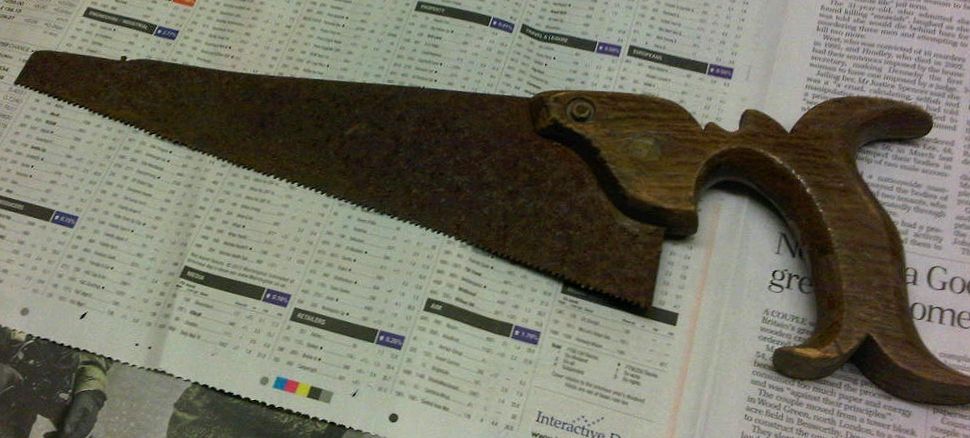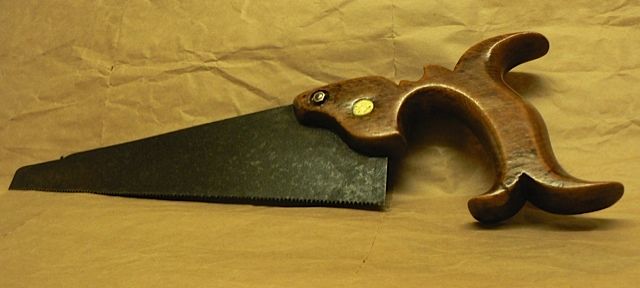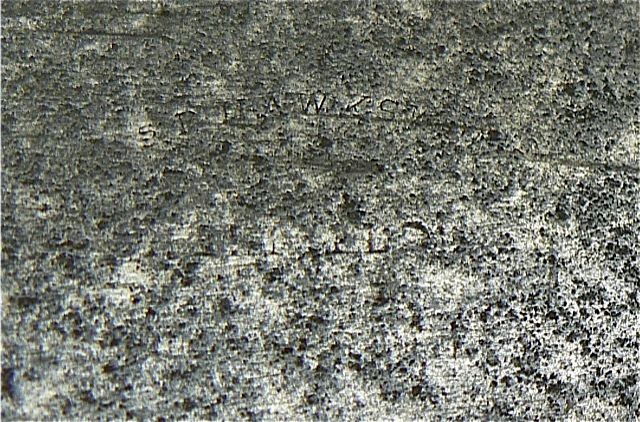As mentioned in another thread I was inspired the other week to rescue this little saw from a trip to the bin - I've seen it hanging uselessly on a very salty wall for several years now and always thought it far too rusty, bent and wormy (not to mention small) to be worth saving. Reading a little bit about saws recently though, I noticed the nib on the back suggesting it was a fair bit older than I'd first imagined.
What convinced me to try and rescue it was simply picking it up and holding it - the handle is incredibly comfortable, a different league to the (much more modern) saws I've used; it really does just feel like a made to measure extension of my hand.
Apologies for the pictures, poor fluorescent lighting partly to blame (incompetent photographer mostly to blame)
As found (picture actually makes it look better than it was!)

Straightened, significant rust removed, teeth levelled a bit, sharpened and set, and handle refinished (picture naturally now makes it look worse than it is)

The best shot I could get of the etch (I was amazed that the etch was still there, given how bad the rust was)

As you can see someone has replaced one of the screws with a nut and bolt (they had the class to use a brass nut!) but as there was no chance of me removing the handle without destroying it and everything was nice and tight, I was happy to leave well-ish alone.
Now the questions... the plate is 10" long and was sharpened with 10 TPI - I don't have calipers here but it's against a rule it's around 0.5mm thick. What is this type of saw called and what would it have been used for? I've seen small saws like this called pruning saws but can't imagine it being much use for that based on my experiences of pruning trees.
Does anyone else have a Hawksworth saw? I see from this http://www.backsaw.net/index.php?option=com_fireboard&func=view&catid=5&id=30&limitstart=10 thread on backsaw.net that the name seems to stretch between 1856 and 1887 ish.
I was most surprised at how well the terrible bends in the plate came out with nothing more than careful reverse bending; the teeth are still a wee bit uneven in height (given the limited depth of the plate I was reluctant to take too much off) but it cuts well and leaves a very clean, narrow kerf.
Not entirely sure what I'll use it for but if nothing else the handle is a perfect pattern for me to copy...
What convinced me to try and rescue it was simply picking it up and holding it - the handle is incredibly comfortable, a different league to the (much more modern) saws I've used; it really does just feel like a made to measure extension of my hand.
Apologies for the pictures, poor fluorescent lighting partly to blame (incompetent photographer mostly to blame)
As found (picture actually makes it look better than it was!)

Straightened, significant rust removed, teeth levelled a bit, sharpened and set, and handle refinished (picture naturally now makes it look worse than it is)

The best shot I could get of the etch (I was amazed that the etch was still there, given how bad the rust was)

As you can see someone has replaced one of the screws with a nut and bolt (they had the class to use a brass nut!) but as there was no chance of me removing the handle without destroying it and everything was nice and tight, I was happy to leave well-ish alone.
Now the questions... the plate is 10" long and was sharpened with 10 TPI - I don't have calipers here but it's against a rule it's around 0.5mm thick. What is this type of saw called and what would it have been used for? I've seen small saws like this called pruning saws but can't imagine it being much use for that based on my experiences of pruning trees.
Does anyone else have a Hawksworth saw? I see from this http://www.backsaw.net/index.php?option=com_fireboard&func=view&catid=5&id=30&limitstart=10 thread on backsaw.net that the name seems to stretch between 1856 and 1887 ish.
I was most surprised at how well the terrible bends in the plate came out with nothing more than careful reverse bending; the teeth are still a wee bit uneven in height (given the limited depth of the plate I was reluctant to take too much off) but it cuts well and leaves a very clean, narrow kerf.
Not entirely sure what I'll use it for but if nothing else the handle is a perfect pattern for me to copy...




































